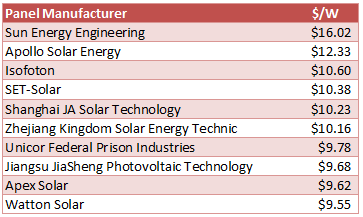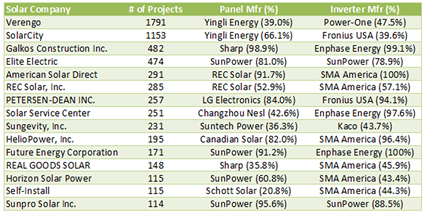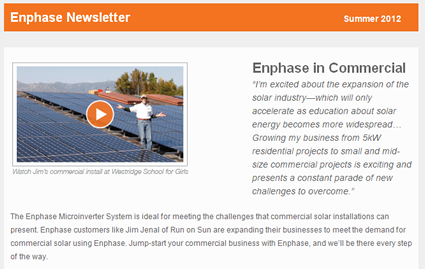Category: "Commercial Solar"
04/10/13
Categories: Solar News, SCE/CSI Rebates, SCE, NABCEP, Commercial Solar, Residential Solar, SDG&E
Picking a Commercial Solar Contractor: NICELY Does It!
Before you can ever get a bid for your commercial solar project, you have to contact a solar installation contractor to come out to your location and perform a site evaluation. Actually, you should contact at least three contractors so that you have a set of bids to compare (more on that process below) - but how do you find them in the first place? Well, you could choose based on who has the most ads on TV or the Internet, or you could rely on Cousin Billy’s recommendation - but somehow that just doesn’t seem sufficiently scientific for a project like this. There has to be a better way - and there is.
If you remember that you need to find someone who will work NICELY with you, success is all but assured. And no, we don’t mean nicely, we mean NICELY - as in:
N - NABCEP Certification
I - Incentive provider (CSI or local utility) connected
C - City building department experienced
E - Electrician on staff
L - Local or national?
Y - Years in business.
Focus on those attributes and you will have found a contractor who will inspire confidence and guarantee a successful project. Let’s expand on why these particular attributes are so important.
NABCEP Certification
 The North American Board of Certified Energy Practitioners - NABCEP for short - provides the most rigorous certification process of solar installation professionals in the industry. Not to be confused with their Entry Level Letter that merely demonstrates that the person has taken an introductory course in solar, the NABCEP Certified Solar PV Installer™ credential is the Gold Standard for installers and consumers alike. Earning NABCEP Certification requires the successful candidate to have an educational background in electrical engineering or related technical areas (such as an IBEW union apprenticeship program), at least two solar installations as the lead installer, and the successful passing of a 4-hour written examination on all aspects of solar power system design and installation.
The North American Board of Certified Energy Practitioners - NABCEP for short - provides the most rigorous certification process of solar installation professionals in the industry. Not to be confused with their Entry Level Letter that merely demonstrates that the person has taken an introductory course in solar, the NABCEP Certified Solar PV Installer™ credential is the Gold Standard for installers and consumers alike. Earning NABCEP Certification requires the successful candidate to have an educational background in electrical engineering or related technical areas (such as an IBEW union apprenticeship program), at least two solar installations as the lead installer, and the successful passing of a 4-hour written examination on all aspects of solar power system design and installation.
As NABCEP notes:
When you hire a contractor with NABCEP Certified Installers leading the crew, you can be confident that you are getting the job done by solar professionals who have the “know-how” that you need. They are part of a select group of people who have distinguished themselves by being awarded NABCEP Certified Installer credentials.
NABCEP’s website offers a database of all Certified Solar PV Installers - just enter your zip code to find the installers located near you. It is with great pride that we point out that at Run on Sun, all three of our owners have earned the designation, NABCEP Certified Solar PV Installer™ - and we know of no other solar power company in Southern California that can make that claim.
Incentive Provider - CSI or Local Utility
A second source of solar installers is the Incentive provider such as the California Solar Initiatives’ Go Solar California website. Every installer who has done a solar power installation for a CSI utility (i.e., SCE, PG&E or SDG&E) will be included on this list. Unfortunately, there are no other criteria associated with getting listed - and there is limited verification done to guarantee that the listed installer is reliable. If your job is in California, your contractor must be on this list - but this is a double-check only - not an ideal starting point for your search.
Another source for information about solar installers is your local utility’s point person for solar rebates. This person deals with installers on a daily basis, and while s/he won’t give you a specific recommendation, they may be able to warn you off of an installer whom they have learned is less than reliable.
City Building Department
Similarly, the folks in your local building department deal with installers regularly as part of the permitting/inspection process. Once again, they won’t be in a position to provide referrals, but they may be able to give you a warning if there are red flags associated with a contractor that you are considering.
Local or National?
Solar installation companies come in all sizes - from national organizations that have crews installing systems all across the country, to local operations that only work in a limited geographic region. To be sure, there are pluses and minuses on both ends — maybe lower prices for the national chain due to economy of scale in their purchasing versus greater attention to detail from a local company that lives or dies based on how well it satisfies its local customer base. And, of course, money spent on a local company tends to stay in the local economy - another consideration in tough economic times.
Years in Business
The last of the NICELY elements is to look at the number of years the company has been in business. Again, this is not a perfect indicator – some recent ventures really have their act together and some long-standing enterprises have long since ceased to really care about what they are doing – but at a minimum you want some assurance that the folks you are doing business with know how to run a business. Otherwise you run the risk of having a largely useless warranty and no one to call if things go wrong.
We would recommend a minimum of three-to-five years in the business of doing solar, with preferably a longer track record of running a business. Expertise in areas beyond just installing solar is also useful such as engineering, management and law.
The preceding is an excerpt from Jim Jenal’s upcoming book, “Commercial Solar Step-by-Step,” due out in July.
08/29/12
Categories: Commercial Solar, Residential Solar, Ranting, 2012
Who's Hot and Who's Not?
The State of SoCal Solar - Part 2
In the highly competitive solar marketplace, some companies are thriving while others are withering on the vine. It’s the age old question: Who’s Hot and Who’s Not? In Part 2 of our series on the State of SoCal Solar, we will answer that question, and more!
In Part 1 of this Series we explained our methodology and looked at some overall trends in the data. To identify the players in the SoCal solar marketplace, we extracted the solar panel and inverter data from our CSI data set. (Unfortunately, the CSI data does not include any information regarding racking equipment used on a project.) While the CSI data allows for multiple different panels and inverters to be identified with each project, in reality the overwhelming majority of projects report only one panel or inverter choice. As a result, we will continue our practice from last year and only look at the first choice reported for both solar panels and inverters.
Top Solar Panels
There are two statistics that are meaningful - the total number of panels utilized and the number of projects on which those panels were employed. We excluded “delisted” projects from our analysis and we will further divide the universe of projects by residential or commercial.
Residential Trends
In the residential space, there are 97 different panel manufacturers listed, but only 15 of them accounted for more than 1% of the total sales volume of 228,372 panels.
Here are our results for the residential market:
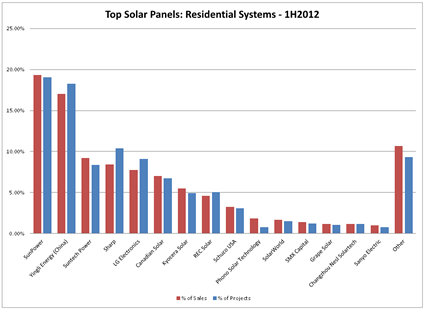 From this analysis it is clear that SunPower and Yingli rule the residential marketplace, combining for 37% of all sales and a comparable share of all projects. New kid on the block, South Korea’s LG Electronics, has jumped out to a very strong start, coming in fifth place behind venerable contenders, Suntech Power and Sharp. Also notable is that Sanyo - a long-time leader thanks to its great efficiency and thermal properties - has nearly fallen off this chart altogether. (Sanyo accounted for just barely 1% of total sales on just 0.8% of all projects.)
From this analysis it is clear that SunPower and Yingli rule the residential marketplace, combining for 37% of all sales and a comparable share of all projects. New kid on the block, South Korea’s LG Electronics, has jumped out to a very strong start, coming in fifth place behind venerable contenders, Suntech Power and Sharp. Also notable is that Sanyo - a long-time leader thanks to its great efficiency and thermal properties - has nearly fallen off this chart altogether. (Sanyo accounted for just barely 1% of total sales on just 0.8% of all projects.)
Those are the results for the residential market overall, but does it make a difference if you distinguish leased projects from cash purchase? Indeed it does, with only three companies having more than 5% market share in both market segments: SunPower (22.8% purchased, 18% leased), Sharp (16% and 5.3%) and Canadian Solar (9.5% and 6%). LG Electronics sold almost all of its product into the leased systems segment with a market share of 10.7% compared to less than one-half a percent in the purchased segment. Altogether, the purchased market segment accounted for 65,841 panels sold whereas the leased segment dwarfed its older sister with 162,531 panels sold.
The top-five most popular residential solar panel models were: Yingli YL235P (21,098 units), LG Electronics 255S1C (15,970), SunPower 327NE (12,273), Suntech Power 190S (11,488) and SunPower 230E (9,069).
Commercial Trends
On the commercial side, there are 60 manufacturers listed, of which only 13 accounted for more than 1% of the total sales volume of 350,360 panels. Here are our results from the commercial side:
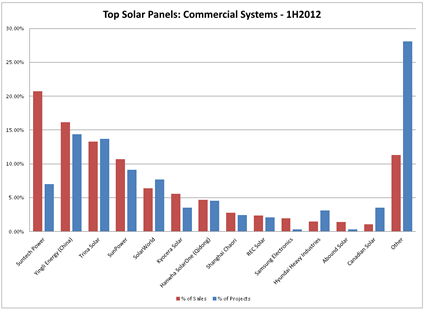 Suntech has taken over from SunPower the top spot in the rankings, accounting for nearly 21% of the panels installed and it did it with only 7% of the total projects. In contrast, second place finisher, Yingli, had more than twice as many projects - 14.4% of the total - but its market share was only 16.2%. While this select group were the only manufacturers to crack 1% of sales, the remaining manufacturers captured a whopping 28% of all projects.
Suntech has taken over from SunPower the top spot in the rankings, accounting for nearly 21% of the panels installed and it did it with only 7% of the total projects. In contrast, second place finisher, Yingli, had more than twice as many projects - 14.4% of the total - but its market share was only 16.2%. While this select group were the only manufacturers to crack 1% of sales, the remaining manufacturers captured a whopping 28% of all projects.
The top-five most popular commercial solar panel models were: Yingli 230P (43,064 units), Suntech Power 280-24/Vd and /Vb-1 (65,475 - two variants), SunPower 327NE, Trina Solar 230PA05 (21,590) and Trina Solar 225PA05 (17,950).
Top Inverter Manufacturers
Analyzing inverter sales is a bit different since many projects have more than one inverter, and in the case of micro-inverters installations, there is one inverter for each solar panel. For our analysis, we will just look at the number of projects with the manufacturer’s product listed as inverter number one.
Residential Trends
The CSI data reveals 24 different inverter manufacturers in the residential space, but only 8 of them cracked the 1% market share threshold. Here are our results for the residential market:
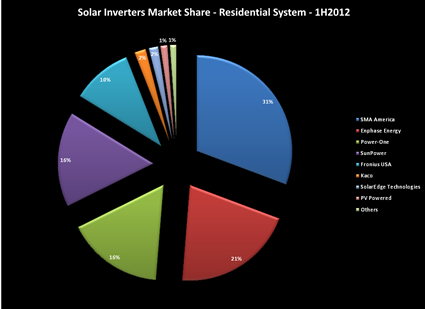 SMA is still the leader, with 31% market share but it is losing ground to our favorite inverter manufacturer, Enphase Energy which now finds itself at 21% of the overall residential market. When just leased systems are considered, Enphase falls to number four with just 12.7%, trailing SMA (32.4%), Power-One (21.7%) and SunPower (16.3%).
SMA is still the leader, with 31% market share but it is losing ground to our favorite inverter manufacturer, Enphase Energy which now finds itself at 21% of the overall residential market. When just leased systems are considered, Enphase falls to number four with just 12.7%, trailing SMA (32.4%), Power-One (21.7%) and SunPower (16.3%).
Buried amidst the 1% that is “other” are some very well known names that appear to have fallen out of favor, such as: Outback Power Systems and Xantrex, as well as newcomers SolarBridge and Enecsys.
Commercial Trends
When we shift our focus to the commercial segment the number of players drops to just 13, with only 11 cracking the 1% barrier. Here are those results:
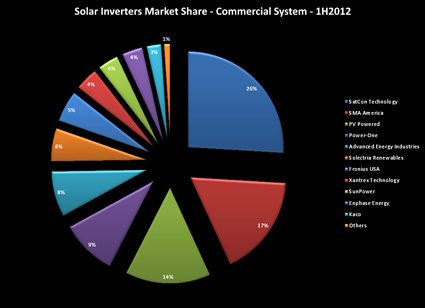 This is a very different graph. SatCon Technology has a clear market lead, despite being dogged by rumors of its imminent demise. SMA is second, but most of that is driven by sales of the same, small-scale string inverters that constitute its products in the residential sector. Enphase weighs in at 3.5%, not a bad number considering that large-scale commercial sales are not its forte (although that may be changing).
This is a very different graph. SatCon Technology has a clear market lead, despite being dogged by rumors of its imminent demise. SMA is second, but most of that is driven by sales of the same, small-scale string inverters that constitute its products in the residential sector. Enphase weighs in at 3.5%, not a bad number considering that large-scale commercial sales are not its forte (although that may be changing).
Popular Pairings
While our CSI data set potentially allows for more than 2,300 different pairings of inverter and solar panel manufacturers, in reality the number of actual pairings is far smaller, with just five pairings accounting for nearly 48% of all projects. Here are the top five pairs:

SunPower - with its 19% market share pairings - clearly demonstrates the joy of vertical integration and a strong improvement over last year when that combination accounted for just 12.4%. The Enphase-Sharp combination comes in at number 2, but at 8.5% the combination has fallen from 10.3% last year. (Given that the overall market share for Enphase improved from last year, this “decline” really reflects a broader base of installation combinations.) Yingli is well represented as is SMA (which, of course, is the dominant driver behind “SunPower” inverters which are mostly SMA inverters re-branded). Nowhere to be seen in the top five is inverter manufacturer Fronius which last year accounted for two of the top five entries but this year did not exceed 4% in any pairing. Likewise, last year’s panel leader, Suntech, failed to reach the top five this year and Kyocera was also pushed off stage with no pairing exceeding 2%.
Who’s Hot and Who’s Not?
Next, as we did last year, we decided to take a look at what pairings are the most, and least, costly, efficient, and ultimately, cost effective. As we noted last year, choosing a second-tier (or third-tier for that matter) solar panel by no means assures you of getting the lowest system cost. In fact, when we looked at the top ten solar panel manufacturers by average cost per CSI AC watt, the results are a bit startling:
None of these are top-tier panels, but they surely are commanding top prices! Keep in mind that our overall average price across all systems (excluding delisted) is just $6.23/Watt and you can see that some seriously overpriced systems were built using these panels.
One measure of panel performance (and the only one that can be teased out of the CSI data) is the ratio of PTC panel rating (meant to more closely reflect real-world conditions) divided by the nameplate panel rating (in STC watts), the higher the ratio the better.
The Sun Energy Engineering panels have a dismal 79.25% rating and the average across all of the panels listed here is under 85%. By contrast, Sanyo panels have an average ratio greater than 89%, ten percent higher than third-tier panels from Sun Energy, yet the systems installed with Sanyo panels averaged $6.84/Watt! (We note with dismay that the entry for Sun Energy panels represents only one system, installed in Malibu - perhaps this was an example of zip-code pricing?)
How do our top pairings rank in terms of dollar per watt? Their numbers are all lower than what we see here, ranging from a high of $8.79/Watt for the average of combinations using REC panels to a low of $6.84/Watt for systems using Yingli panels.
What about efficiency? Which equipment pairings produced the highest and lowest efficiency ratings (as measured by the ratio of CSI Rating divided by Nameplate)? This is a more involved number, since it is not simply a function of efficient equipment (although panel PTC/STC rating and inverter conversion efficiency are both included) but also the specifics of the site - azimuth, tilt, shading and geographic location. Nevertheless, good equipment certainly helps so let’s see where the numbers fall. One additional restriction is required - we will limit this to the residential sector. Why? Because larger commercial projects often using tracking mounts that can have efficiencies greater than 100% and would skew our results away from the panel-inverter pairing.
So with that limitation in mind,the highest combination of panels and inverters in terms of efficiency is First Solar panels (thin film) combined with a Fronius inverter for a 90.51% efficiency score (thanks in part to the thin film panels great PTC to STC rating) while the lowest end is a depressingly low of 68.45% derived from MAGE Solar panels and inverters from SolarEdge. (Not clear if even “power optimizers” can rescue a site with such dismal design characteristics.)
What about our most popular panel-inverter combinations - how did they fare on the efficiency scale? Not surprisingly, the SunPower-SunPower combination is the winner at 84.38%, but four of our five favorite pairs are closely bunched: Yingli-SMA (83.28%), Sharp-Enphase (82.43%), and Yingli-Power-One (82.35%). The lone outlier was REC-SMA which came in at a relatively low 80.11%.
Who Uses What?
Finally, as we pivot from a pure equipment analysis to one more focused on the practices of the solar installation companies, we wanted to see what the biggest players are using and how does that affect their pricing? Last year we looked at the top five players, but to give us a broader picture this time around we are looking at everyone with 100 or more projects (excluding projects that are delisted). Here are our results:
First a comment or two on who made the top five in this list - SolarCity and Verengo have swapped places, Galkos remains at number three (despite our observations about them last year) but REC Solar and Real Goods have been driven down the chart (to numbers six and twelve respectively) to be replaced by previously uncharted Elite Electric and American Solar Direct. (We will have more to say about all of these folks in Part 3.)
Last year Kyocera was the panel of choice for two of the top five; this year Kyocera did not crack the top fifteen, although it was the second choice for SolarCity. LG Electronics found a niche with Petersen-Dean (and was the second choice for Verengo), while Chinese panel manufacturers dominated the list, capturing five of the fifteen slots. Indeed, the big winner on this list would have to be Yingli, increasing its share of SolarCity’s business from 48% last year to 66% now and pushing aside its countrymate, Suntech, to become the number one choice at Verengo. It will be interesting to see how the ongoing trade dispute and imposed tariffs change these rankings next year.
Power-One gets the big boost this year in terms of inverter choices - elbowing past SMA for the top spot with overall leader, Verengo. But if you want to talk brand loyalty, Enphase is the clear winner - when it cracks the list it is used more than 97% of the time!
Collectively, these fifteen installation companies accounted for two thirds of all the solar projects in our CSI data set - but did that translate into lower prices for their customers? To answer that question - and a whole bunch more - in Part 3 we will turn our attention to Outliers and Oddities to discover the good, the bad and the ugly amongst solar companies. You won’t want to miss it!
08/22/12
Categories: Commercial Solar, Westridge PAC Project
Enphase Features Run on Sun and Westridge School for Girls
We have written at some length about Enphase micro-inverters in the past, but today Enphase returned the favor. Here was the lead story in their Summer 2012 Newsletter that just went out this morning:
That is Run on Sun Founder & CEO, Jim Jenal, posing amidst our solar installation at the Westridge School for Girls here in Pasadena. The article quoted Jim and provided a link back to our video highlighting the Westridge installation. Pretty cool.
Even cooler, however, was the meeting that we had this week with Mark Abrams, the Director of Product Management for Enphase. We met with Mark to provide him with feedback about their existing products and to offer our insights about their next generation product that is still in prototype. This was a great exchange - we told Mark what we loved about their products - but also important ways in which the product could be improved, at least in the eyes of an installer! Mark listened intently, took notes, and promised to see what he could do to incorporate our feedback.
It is hard to over estimate the value of such interactions between manufacturers and installers, yet it doesn’t seem to happen as often as it should. So here’s a note to the rest of the manufacturers out there - if you really want to improve your products, start spending (more) time with installers, and I don’t mean your sales people. (Trust me, we already get more than enough contact from your sales reps.) You might not like everything that you hear, but learning first hand what our problems are is the best way to build a long-lasting relationship with the folks who are the most important to your long-term success.
After all, that might be Jim’s face that you see in that photo, but it’s Enphase’s products that made that project a reality.
05/04/12
Categories: Commercial Solar, Non-profit solar, Westridge PAC Project
Putting it All Together - Installing Solar at Westridge - Part 5
Here it is - our video from our 52.3kW solar project at the Westridge School for Girls here in Pasadena. Enjoy!
You can follow this link to see the complete series:
Installing Solar at Westridge.
Categories: All About Solar Power, PWP Rebates, PWP, Commercial Solar, Non-profit solar, Westridge PAC Project
Westridge Project Grabs Pasadena Weekly's Green Issue Front Page!
 Readers of this blog will know all about the 52.3kW solar project that Run on Sun just recently completed installing at Pasadena’s renowned Westridge School for Girls. Now that project has become the cover story in the Annual “Green Issue” of Pasadena Weekly.
Readers of this blog will know all about the 52.3kW solar project that Run on Sun just recently completed installing at Pasadena’s renowned Westridge School for Girls. Now that project has become the cover story in the Annual “Green Issue” of Pasadena Weekly.
Titled, “Solar Flair: New solar installation at Westridge School brings environmental lessons to life,” the piece features interviews with Westridge’s Head of School, Elizabeth McGregor, Facilities Manager Brian Williams, and three students who are part of the school’s environmental group known as the Green Guerrillas. The story reveals the school’s deep commitment to sustainability in everything from solar power to drought tolerant plants.
This first of what we hope will be many solar projects at Westridge really highlights the value of these projects for all schools, especially those in the Pasadena Water and Power service territory. Good rebates and a solar company that really understands your goals makes a solar power system installed by Run on Sun a “no-brainer.”
Contact us today and let’s get going with YOUR solar project!
